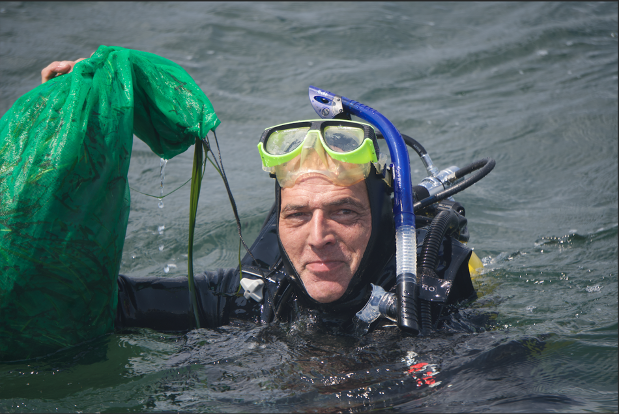
after the dive at Fisher’s Island. (Image: Emma DeLoughry)
Eelgrass is an important seagrass and a building block for a healthy and abundant Long Island Sound. It provides a number of important ecosystem function, including carbon capture and sequestration, shelter and foraging areas for young fish and invertebrates, food for migratory waterfowl and sea turtles, and habitat for important local species including flounder and bay scallops. For this reason, eelgrass meadows are one of the most biodiverse marine habitats in our region. Eelgrass once lined the bays and coves of the Sound, however, water quality degradation and coastal construction and hardening drove a 90% decline in eelgrass in the Sound. For the past decade there has been a concerted effort by the Long Island Sound Study, state agencies, universities and conservation groups to monitor, restore and rebuild the eelgrass meadows.
One recent contributor to this effort is inventor Rob Vasiluth. “At first I didn’t know about all the great things that eelgrass does”, Rob admitted, but “once I did more research, I started thinking about how to use an animal to build an entire meadow.” Rob’s idea resulted in a research project with Stony Brook University’s Southampton Marine Station and the Cornell Cooperative Extension Program (CCE) that aims to increase eelgrass propagation throughout the Long Island Sound by using clams as an alternative to traditional planting methods. This project, which is already underway, will be completed in multiple phases throughout the coming months.
The first phase, eelgrass seed collection, was completed on July 28th, 2021. Scuba divers from Save the Sound’s Soundkeeper team and the CCE Eelgrass Program collected eelgrass seeds from a population of adult shoots at Fisher’s Island. During the next phase of the project, these seeds will be glued onto clams that will be released into the Sound. Researchers are hopeful that when these clams bury themselves underneath the sand the eelgrass seeds will plant and germinate.
A shining example of eelgrass habitat can be seen at Fisher’s Island where the dive took place. The eelgrass meadows around Fisher’s Island alone make up nearly 25% of the seagrass that remains in the entirety of the Long Island Sound. This is largely due to the success of the Fisher’s Island Conservancy Eelgrass Management Program that is responsible for stewarding the last best eelgrass habitat in the Sound. We are hopeful that this will be a source for restoring the historical seagrass range within the Long Island Sound.

This valuable eelgrass source as well as the dedication and passion of a multitude of individuals and organizations throughout the Long Island Sound paints an optimistic picture for the future of eelgrass populations in our region. Rob Vasiluth, for one, says “I’m committed to seeing this to fruition. They say I have tenacity that is through the roof, but in simple terms I’m determined to make a difference and help to save what’s left.”
For more information please visit: http://www.seagrassli.org/
